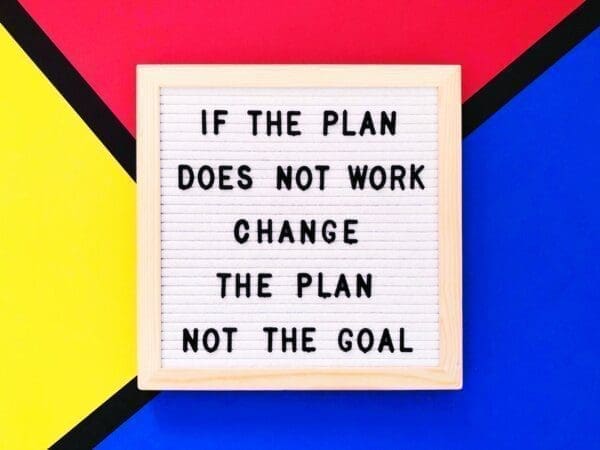Set Out the Vision and Lead the Way
Implementing change is an inevitable fact of business life. Companies change and evolve, to remain competitive. Today’s business challenges are greater than ever, navigating life after the pandemic and the ongoing impact of the Ukraine war. Adding further complexity, leadership teams are expected to be morally sound, act ethically and embrace sustainability and diversity. And they have a duty of care to their employees.
In this article, we look at how to implement change in businesses and safeguard your people. Depending on the change, your people are likely to be impacted in different ways. You have to lead them through the change. But you also need to show empathy and take care of them. We talk through all that. And at the end we have 10 steps to change your life, to help you embrace the changes happening in your business.
What Does it Mean to Implement Change in a Business, and Why Do People Do it?
When you implement change, you shift the way you operate. Whatever happens, things are going to be different. From the outset, you need to be clear about what you intend to do differently, and why. There are many reasons businesses make changes. Here are some common ones:
- Responding to the external environment: unforeseeable events like the pandemic and Ukraine war, economic conditions, new laws, rule changes like HFSS, new tech, competitor activity, customers changing, and consumer trends.
- Restructuring after a change of company ownership.
- Changing business strategy with a new CEO.
- Realising a particular vision.
- Making new ideas succeed.
- Becoming more sustainable.
- Increasing revenues.
- Reducing waste or costs.
- Increasing performance and productivity.
- Decreasing risk.
- Improving profitability.

Operational Changes Might Include:
- Business reorganisation.
- Changing work roles and working practices.
- Implementing new software or equipment.
- Going from brick and mortar to e-commerce.
- Rebuilding the website.
- Launching a new department.
Implementing these changes is likely to involve another kind of attitude change. Managers are likely to be switching from their usual silo structure to working with colleagues in a cross-functional matrix. As they work more closely together, this co-operation will bring clear benefits in building working relationships and fresh insights,
How Does That Make You Feel? Change Can Damage Your Mental Health
One of the greatest recent business shifts is the increased importance attached to safeguarding employees’ mental health and wellbeing. Implementing change involves dealing with people, with feelings and emotions. You’re changing lives. Change is the external event or situation that’s happening in the business. Transition is the inner process people go through as they internalise and come to terms with it.
Sticky Learning ® is 7 times more effective than 1-day training courses. Plus, you will get a Chain of Evidence proving your Return on Investment. Discover soft skills training that changes behaviours long term.

What are the 4 Steps in the Change Process?

The psychological stages are shock, anger, acceptance and commitment. It’s a similar journey to loss and bereavement. People’s initial reaction will likely be shock or denial, as they refuse to accept change is happening. Once reality sets in, they often react negatively.
Various change management models have developed over the years, based on psychological insights. Leaders and managers’ duty of care for employees can get overlooked when their attention is elsewhere. Change management models help you understand what your people are going through. And they’ll help safeguard your employee’s wellbeing in challenging times.
How do Leaders Implement Change?
Here are 6 recognised steps leaders and managers use to implement lasting change in organisations:
- 1: Prepare people for the change.
- 2: Explain the change.
- 3: Acknowledge the ‘loss’ factor.
- 4: Create the right climate.
- 5: Build the plan.
- 6: Launch the change and sustain it.
How Do You Implement a Strategy Successfully?
We’ve talked about the impact on employees. Implementing change can also be challenging for leaders and managers, because of the uncertainty of the outcome. To manage your anxiety and help you focus, think of the change as simply another business strategy to implement.
Here’s a quick refresh about implementing strategies:
- Set clear goals and define the key variables.
- Determine roles, responsibilities and relationships.
- Delegate tasks as appropriate.
- Execute the plan, monitor progress and performance, and provide continued support.
- Take corrective action – adjust or revise as necessary.
- Get closure on the activity, and agreement on the output.
- Conduct a review of how the process went.
What are the Best Strategies to Implement Change?

As we’ve mentioned, change implementation strategies need to take into account the ‘human factor,’ the change’s impact on the people. Experts also recommend these strategies:
- Plan carefully: Have a plan in place with everything documented. We’ll look in more detail at change management plans in a moment.
- Be as transparent as possible: Have the answers to people’s questions. If you can’t give all the details, being upfront about what you CAN share will make people feel more comfortable.
- Tell the truth: Be honest. Optimism’s good, but presenting unrealistic outcomes makes people suspicious and distrustful. Acknowledge the potential challenges and drawbacks of the change.
- Share the roadmap: Help people understand where the business has come from, and where it’s going. This will help them grasp the idea behind the change and see how it fits in with what they’re used to.
- Don’t expect change overnight. Take it slowly, you can answer questions and get people on board. Some people will be slower to adopt new habits, so give them time.
- Demonstrate inspirational leadership.
How Do You Implement Changes in an Organisation? Introducing The Change Management Plan.
A change management plan will support a smooth transition, and ensure your team are guided through the change process. Here are 6 key steps to incorporate, to implement change:
1. Clearly Define the Change and Align it to Your Business Goals
Be clear about the change you need to make, and the reasons. Review the proposed change against your current objectives and goals. Will it take you in the right direction, strategically, financially and ethically? Work out the added value the change will bring, and how much you need to invest in time and resources.
2. Determine the Impacts, and Who Will Be Affected

Review the likely effect the change will have on each part of the business, and how it will affect individuals. Figure out where people will need training and support, to soften the impacts. Who will the change affect most? How will they receive it?
3. Develop a Communication Strategy
You need to take everyone on your change journey. But there are some you must communicate the change to, early on. Decide the most effective way of communication to bring them on board. Think about your objectives, audiences, messages, and the channels and media you want to use. It’s really important to get this right and learn from the feedback. Keep an ear to the ground. Read our articles on internal and external communications and grapevine communication.
4. Provide Effective Training
Once the change message is out there, it’s important your people know they will get the training they need. This covers the necessary skills and behaviours. Do it face to face, online or a mix. Look on the change as an opportunity for developing people.
5. Put a Support Structure in place
It’s crucial to help your employees at all levels adjust emotionally and practically to the change. Various companies have trained mental health first aiders. Going back to change management models, Tuckman’s Model looks at how teams develop. Some changes will mean redundancies and restructuring. Consider offering people counselling services to help them. Think about the people who need support most. What kind of support will be most effective?
6. Measure the Change
You need a system in place to measure the change’s impact, and ways to reinforce what’s going well. Check progress against the change management plan and incorporate lessons learnt, including from feedback.

What Resources Do You Need to Implement Change?
The resources you require may include people, finances, information and technology. In planning these, you need to be flexible, as unforeseen obstacles may come up that call for a rethink. You’ll also need to be creative, as you may have a limited budget. Lastly, the change may mean you’re using new tech. You will need to train people to use it.
8 Methods of Implementing Change
- Transformational leadership has a vision and initiates bold strategic changes.
- Leadership provides a rationale for change.
- The team bring pressure on individual members to embrace the change.
- Team members participate in shaping the change and implementing it.
- Leaders and managers build employee support for the change by sharing the rewards it brings.
- The business ensures employee security in the change, by safeguarding earnings, seniority rights and opportunity for advancement.
- Company-wide communication and education encourages people to support the change.
- Leaders and managers make employees aware of the need for change, and managers are aware of the changing work relationships.
How Do You Implement Positive Changes in the Workplace?
Change can be hard for employees to take, but leaders and managers can do a lot to help them. Acknowledging the sense of loss and creating a supportive climate will help your people move on into the new reality.
You Can Implement Positive Changes in Your Business’s Culture in These Proven Ways:

- Promote optimism: We absorb motivation and enthusiasm from people around us. Encourage your people to be mentors to teammates and colleagues and motivate them to stay positive. Start meetings with people checking in about how they are feeling. Help everyone believe they can achieve their goals with motivation and the right guidance. As the leader, show them a positive attitude and model the right way of doing things.
- Share feedback effectively: Positive leadership means sharing feedback that creates positive impacts and helps people learn and improve. The customer experience software company HubSpot says 98% of employees disengage when they get little or no feedback from superiors. 65% of employees are in favour of receiving feedback. And over 40% of employees who are engaged, get feedback every week.
- Turn challenges into opportunities: Challenges don’t put off those people who believe in themselves. Encourage your team to see challenges as a new beginning.
- Endorse empathy: Address your team’s apprehensions with compassion. Understand the vulnerabilities they may be facing, and the stress and anxiety. Give them a sense of belonging and security.
- Empower your team members: Give people space and flexibility to adjust to the change. Micromanaging leads to confusion and negativity.
- Recognise outputs, not just outcomes: Things may not be easy while the change beds in. Recognise people’s efforts, not just the results they achieve. This will keep teams productive and encourage them to keep giving their best.
- Foster conducive workplace relationships: Relationships between employees have a direct impact on productivity and profitability. Encourage people to take pride in each other’s success, rather than envying it.
And Finally: Popular Hacks to Help You Get Started
Here are some popular hacks to be successful in implementing change in your business:
3 Cs of Effective Change Management

- Communicate: Concentrate on the ‘what,’ and also the why. Explain the change’s purpose, how it fits with your values and the likely benefits, and people will buy in quicker.
- Collaborate: Get people to work together across the business. Involving people in decision making early on and frequently engaging them will strengthen their commitment.
- Commit: Make sure people see your beliefs and behaviours support the change. Be resilient and persistent, prepared to step outside your comfort zone. Give time to the change effort and focus on the big picture.
A ‘Top 20’ of Helpful Change Strategies
1-11
- Get buy in from the whole business.
- Identify your change scope clearly.
- Hire people who are enthusiastic about change.
- Create a cross-team change management project team.
- Prepare for the change with open communication.
- Build a change implementation plan.
- Get feedback from your employees.
- Launch small-scale pilots for the change.
- Set deadlines for the change.
- Document the process for the change.
- Train your staff on how to manage change next time.
During the pandemic and afterwards, businesses have been implementing agile working practices. These are often put in place at speed. Our last 9 strategies come from an Australian company’s 12-week change management programme:
12-20
- Enlist champions.
- Establish goals.
- Anticipate obstacles.
- Develop a plan.
- Tackle technology issues.
- Address health and safety issues.
- Implement changes week by week.
- Coach line managers in agile working practices.
- Provide post-implementation support.
And finally, you may want to change your own life, to help you embrace the changes happening in your business. Here are 10 steps, drawing on life coaches’ and therapists’ advice for people making lifestyle changes:

- Step 1: Decide to change your life.
- Step 2: Learn to embrace discomfort: think about doing things differently from before.
- Step 3: Identify WHY you want to change.
- Step 4: Define the changes you want to make.
- Step 5: Identify things that may hold you back from succeeding.
- Step 6: Choose one thing to focus on to start with: you can’t do everything at once.
- Step 7: Set SMART goals: Specific, measurable, achievable, relevant and timebound.
- Step 8: Prepare for the storm: no one tactic can make you magically “get there.” But there are things you can do to be in a good place. Think about self-awareness and selfcare. And look after your physical and mental health.
- Step 9: Choose people to support you. Be wise in who you choose.
- Step 10: Go the distance. You won’t change your life in a few short weeks, it’s going to take longer.
As Bill Gates famously said,
“Most people overestimate what they can do in a year, and underestimate what they can do in a decade.”
You can implement change in your life as much as you can in your business, but here again, you need to give it time.




